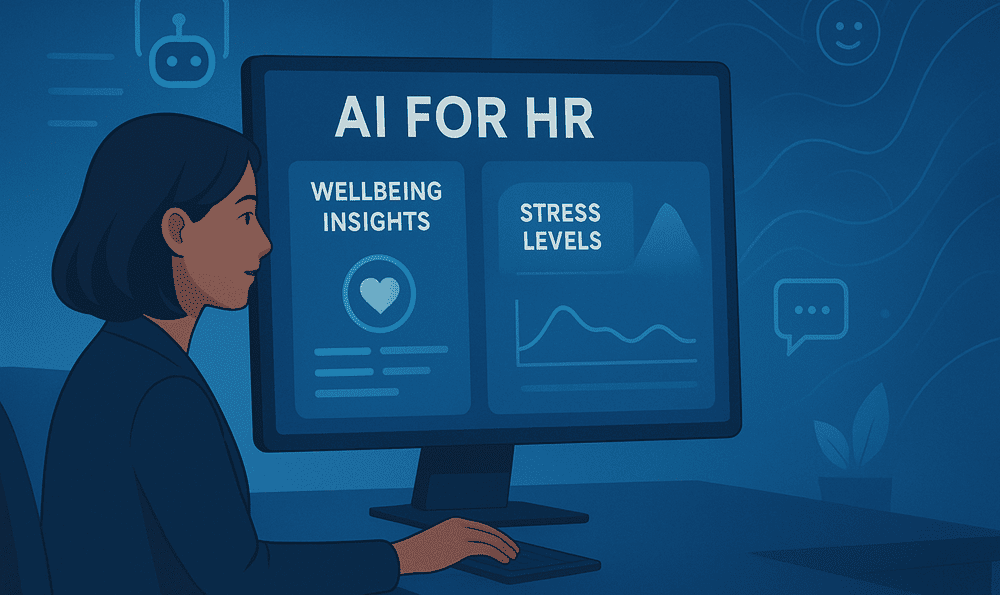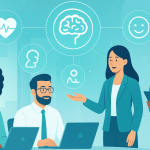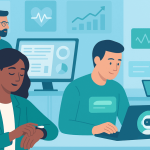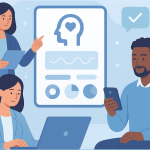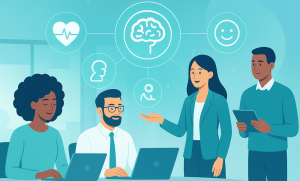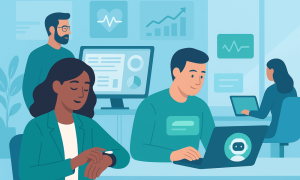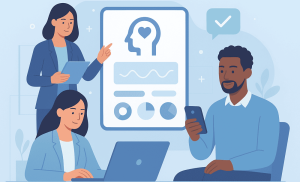Employee wellbeing has become one of the most pressing challenges for organizations today. Rising stress levels, burnout, and workplace anxiety are impacting productivity, retention, and overall morale. Traditionally, Human Resources teams have relied on manual surveys, annual wellness programs, or one-off check-ins. But these methods often fail to capture real-time employee needs.
Now, HR mental health AI is transforming the way organizations support employees. By automating check-ins and offering personalized, proactive care, HR leaders can create healthier, more resilient workplaces.
Why Mental Health Check-Ins Matter for HR
Human Resources is the bridge between organizational goals and employee wellbeing. Yet, in many workplaces:
- Stress and burnout remain undetected until they escalate.
- HR professionals juggle multiple priorities and lack resources for ongoing mental health monitoring.
- Employees hesitate to discuss personal struggles due to stigma or privacy concerns.
These challenges highlight the need for innovative solutions. Automated mental health support powered by AI offers HR teams a scalable, data-driven way to engage employees consistently and confidentially.
What Is HR Mental Health AI?
HR mental health AI refers to artificial intelligence solutions designed to monitor, assess, and support employee wellbeing. Unlike traditional EAPs or annual surveys, these systems provide real-time insights and continuous engagement.
Key features include:
- Automated employee check-ins using chatbots, voice AI, or mobile apps.
- AI wellbeing HR dashboards that provide anonymized workforce insights.
- Sentiment analysis that identifies stress patterns in communication.
- Predictive analytics that flag employees at risk of burnout.
- Personalized nudges for stress management, workplace mindfulness, and resilience.
The result: HR teams can move from reactive interventions to proactive, preventive strategies.
How AI Automates Mental Health Check-Ins
Automation doesn’t mean impersonal. In fact, AI employee check-ins can feel more approachable for employees, who may prefer sharing concerns with a digital assistant first. Here’s how automation works in practice:
1. Daily or Weekly Micro Check-Ins
Instead of long surveys, employees receive short, conversational prompts—like “How are you feeling today?” or “What’s your current stress level?” The AI uses natural language processing to understand mood and provide quick resources.
2. Stress Detection Through Digital Behavior
AI tools can analyze communication patterns—like email tone or meeting overload—to detect stress signals. If an employee consistently sends late-night emails, the AI may suggest a break or flag patterns to HR via digital HR stress support systems.
3. Confidential Wellbeing Recommendations
Employees receive personalized resources such as mindfulness exercises, sleep tips, or resilience coaching, without HR accessing private details. This ensures confidentiality while offering real-time support.
4. HR Dashboards with Insights
Behind the scenes, HR leaders gain anonymized reports highlighting team stress levels, wellbeing trends, and engagement rates. These insights enable mental health HR automation strategies that address issues before they spiral.
Benefits of HR Mental Health AI
Implementing HR mental health AI brings value to both employees and organizations.
- For Employees:
- Accessible, stigma-free support.
- Personalized recommendations for wellbeing.
- Greater sense of being “heard” consistently.
- Accessible, stigma-free support.
- For HR Leaders:
- Scalable monitoring without overwhelming HR staff.
- Actionable insights from AI wellbeing dashboards.
- Better allocation of resources for counseling or wellness programs.
- Scalable monitoring without overwhelming HR staff.
- For Organizations:
- Lower absenteeism and turnover.
- Higher employee engagement and morale.
- Increased efficiency through HR productivity AI tools.
- Lower absenteeism and turnover.
Practical Use Cases of AI in HR Mental Health
Many organizations are already leveraging AI-powered mental health support. Examples include:
- Automated mood check-ins delivered via Slack or Teams.
- AI-driven wellbeing surveys that adapt questions based on employee responses.
- Chat-based digital wellness coaches offering immediate stress-relief exercises.
- Predictive alerts notifying HR about potential burnout risks at the team level.
These practical applications illustrate how AI is making HR not only more efficient but also more human-centric.
Addressing Concerns: Privacy and Trust
One of the biggest concerns with HR mental health AI is data privacy. Employees must trust that their information is handled responsibly. Ethical AI implementation requires:
- Strict confidentiality: No individual data should be shared with HR or management without consent.
- Anonymized reporting: Insights are aggregated at team or organizational levels.
- Transparency: Employees should understand what data is collected and how it’s used.
By building transparent policies, HR leaders can ensure employees embrace AI tools without fear.
The Future of AI in HR Wellbeing
The next generation of HR tools will go beyond surveys and dashboards. Future trends may include:
- Voice-based AI employee check-ins for natural, conversational support.
- Integration with wearable devices to monitor stress signals like heart rate or sleep quality.
- Advanced predictive modeling that helps HR anticipate large-scale burnout risks.
- Hybrid AI + human coaching models, where digital tools provide daily support and escalate issues to counselors when needed.
These innovations will redefine how companies approach mental health HR automation, ensuring employee wellbeing becomes a core business strategy.
Why HR Leaders Should Care Now
The pressure on HR has never been greater. Leaders are expected to drive productivity, manage hybrid workplaces, and support employee wellbeing—all at once. HR mental health AI offers a practical way to balance these demands.
By embedding AI-driven check-ins into HR workflows, organizations can:
- Foster a culture of wellbeing and resilience.
- Reduce the stigma around mental health conversations.
- Provide support at scale, even in large global workforces.
- Demonstrate genuine commitment to employee wellbeing.
This shift also aligns with broader workplace strategies like AI for mental wellbeing, workplace mindfulness, and AI resilience coaching, showing how technology can make HR more proactive and empathetic.
Final Thoughts
Employee wellbeing can no longer be left to annual surveys or reactive interventions. With HR mental health AI, organizations now have the ability to automate check-ins, personalize support, and act proactively on wellbeing insights.
This isn’t just about technology—it’s about reshaping HR into a driver of sustainable performance and human-centered leadership. By adopting AI wellbeing HR solutions, organizations create workplaces where employees feel supported, engaged, and ready to thrive.
The future of HR is digital, empathetic, and intelligent. And with the right tools, it starts today.

